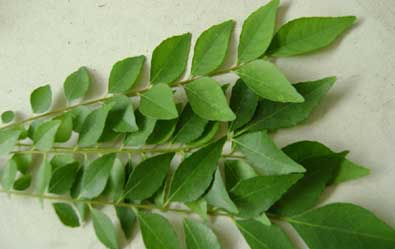 The leaves of curry leaf tree is a spice. The aromatic curry tree(Chalcas koenigii), a member of the Rutaceae family is five meter in height, 15-40 cm in diameter. It is cultivated mainly in homesteads but to a certain extent on a plantation scale.
The leaves of curry leaf tree is a spice. The aromatic curry tree(Chalcas koenigii), a member of the Rutaceae family is five meter in height, 15-40 cm in diameter. It is cultivated mainly in homesteads but to a certain extent on a plantation scale.
A fast-growing shrub with deep roots and scented leaves are an important ingredient in curry in South India and Sri Lanka. Fresh curry leaves are oval in shape and best used at about 1 inch in length. They have a pungent and bitter smell much like the leaves of a citrus tree.
Origin and Distribution
The small deciduous curry is native to India. Curry leaves are extensively used in Southern India and Sri Lanka (and are absolutely necessary for the authentic flavor) but are also of some importance in Northern India. Together with South Indian immigrants, curry leaves reached outside the Indian sphere. In the East, its range extends into Burma, Malaysia, South Africa, and Reunion islands.
Cultivation
Although the curry leaf plant is found in the wild, it is also widely cultivated for its aromatic leaves and as an ornamental. The plant is grown in almost every home garden in south India. All it needs is some watering during a dry spell and some sunshine during cold months. It can withstand a small amount of frost and needs moderate light and warmth to grow. A small pot with these aromatic leaves can be kept in a partially indoors area, to stave off insects etc too, as well as ensure a fresh aroma to the area.
Planting in southern India is mostly done just before the arrival of the monsoon in May. It is propagated by seeds, which germinate freely under partial shade. The leaves can be harvested about 15 months after planting, and a fully grown tree can yield about 100 kg leaves each year.
Storage
Curry leaves should not be removed from the branches until needed. They can be stored, tightly wrapped, in the refrigerator, for up to two weeks. They may also be frozen.
Culinary uses
Curry leaves are highly aromatic and are used as a herb or spice. They are mainly used fresh but are also used dried or powdered. For some recipes, the leaves are oven-dried or toasted immediately before use. They are extensively used in Southern India as a natural flavoring agent in various dishes, mainly vegetarian, like sambar, khaman dhokla, rice preparation, etc. It is also used in Srilanka and many other parts of the world. In Sri Lanka, the delicious chicken and beef curries are flavored with curry leaves. The western world is fast taking enthusiastically to Indian curry leaf for relishing tangy foodstuffs that are not too hot. Curry Leaves are typically fried until brown, then cooked with the dish. Because of their soft texture, they are never removed before serving but can be eaten without any hazard.
Other Uses
Curry leaf is mainly a culinary plant and is cultivated as an ornamental throughout South Asia. It also has a few lesser-known uses.
Use Of Wood
The wood of the curry leaf tree is greyish-white, hard, close-grained and durable. It has been used to make agricultural tools.
Oil Extract
Curry leaves are steam distilled to produce an oil which is used for the production of soap. Its oils are invaluable as repellants and to cure skin disorders.
Beauty Treatments
It can also be ground into a paste with some turmeric and applied on acne infected skin for a few days. The result is a glowing, clear skin. Curry leaves boiled with coconut oil can be an effective hair colorant which causes minimum damage and maximum benefit to graying or thinning hair. South Indian women have, for centuries, mixed the leaves with fenugreek, and applied as a paste to keep hair long, back and gleaming.
Medicinal Uses
Apart from these, the leaves, bark, and root of the plant are used for various medicinal applications. It is an essential ingredient of almost all traditional medicine systems of India. Ayurveda and other systems use it to cure ailments such as piles, constipation, nausea, and diarrhea. It has also been proven by experts of western medicine that they are useful in leucoderma and blood disorders. It is also used in treating skin irritations and poisonous bites.